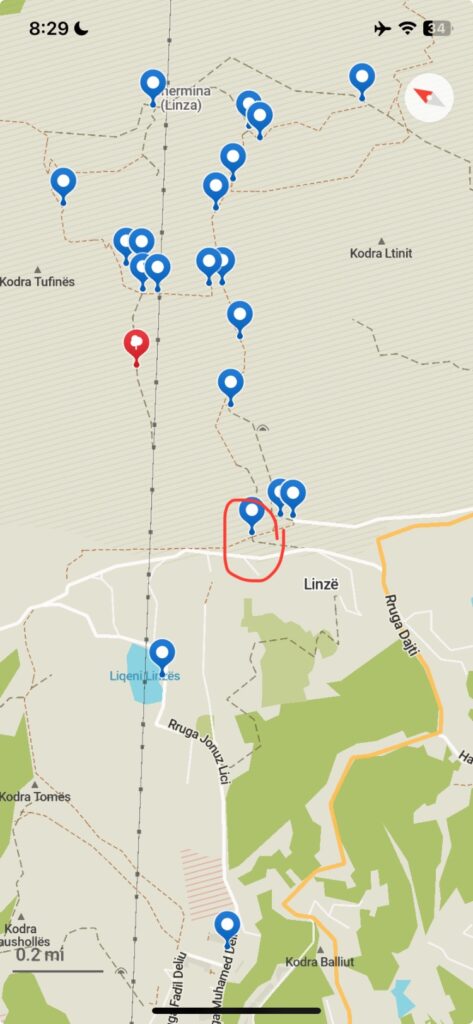The fragrance of jasmine fills the streets, and flowerbeds overflow with roses of every color. Artists have converged to create buildings that are far more than just functional, turning Tirana, Albania into a photogenic city with their architectural designs. The rugged mountains in the backdrop add the finishing touch to Tirana’s beauty.
Very few cities enamor Trin and me. We usually prefer the quiet solitude and beauty of nature, but Tirana captured our imagination.

The Pyramid of Tirana: Oppression to Freedom
The Pyramid of Tirana has a controversial history. Originally built as a tribute to communist dictator Enver Hoxha, the structure symbolized his oppressive regime. Hoxha, a paranoid dictator, isolated his people from the rest of the world, seeking to convince them that global forces were against them. He persecuted those faiths different from his. His faith was in atheism and himself. Suspected dissenters were tortured or killed, and he squandered the country’s resources on bunkers scattered throughout Albania.
This architectural tribute represented tyranny to many, sparking campaigns for its destruction. Instead, the city transformed what was meant for evil into a beacon of freedom and exploration. Inside, the Pyramid now houses open work spaces and community activity centers, fostering learning and connection. The once impenetrable concrete exterior has been converted into steps, inviting individuals to ascend and view the city from new heights. At the top, a cafe offers a spot for coffee, making the once forbidding structure now inviting.

Tirana has taken this symbol of a difficult past and transformed the Pyramid into a centerpiece representing a transformed city. Rather than tearing it down, they have built something stronger and more meaningful.
Today, the constitution of Albania guarantees the freedom of conscience, beliefs, and religion.

Skanderbeg Square: The Heart of the City
A trip to Albania would not be complete without visiting at least one of the many monuments dedicated to Skanderbeg, a national hero. Tirana honors him at the heart of the city in Skanderbeg Square. Significant landmarks surround this expansive open space, including the National History Museum, the Et’hem Bey Mosque, and the Opera House. The square also features a grand monument of Skanderbeg himself.
Skanderbeg Square serves as the central hub of Tirana, hosting cultural events, political gatherings, markets, and leisure activities. At night, the marble square reflects the surrounding lights, giving it the appearance of placid water and creating a serene atmosphere amid the bustling activity.

Gjergj Kastrioti Skanderbeg (1405–1468) exemplifies transformation much like that of the Pyramid of Tirana. He turned a challenging past into heroism. As a child, Skanderbeg was taken hostage by the Ottoman Empire. The Ottomans practiced Devshirme, forcibly taking children from Balkan Christian families to the Enderun School, where they were forced to convert to Islam and trained as soldiers for the empire’s expansion. Skanderbeg, however, resisted conversion and used his education to become a formidable opponent of the Ottoman Empire. He earned his place in history by leveraging his military skills to halt the Ottomans’ expansion, leading his people to freedom.





Architecture of Tirana: From Brutalism to Elegance
Tirana’s architecture reflects its diverse history, from its Illyrian roots to Ottoman rule, the Italian occupation, and from tyranny to freedom. The city’s past is etched in its buildings, yet its modern transformation sets it apart. During the communist regime, Soviet-style concrete blocks dominated Tirana, serving functional purposes while symbolizing the subjugation of workers.
With Albania’s liberation, city planners began transforming the brutalist landscape into something elegant and vibrant. Color, innovative design, and artistic expression are rapidly reshaping Tirana’s skyline. This evolution symbolizes hope and underscores our inherent need for beauty to thrive. The city is flourishing and tourism is rapidly growing even as the city is under construction in its transformation.

Parks of Tirana
Within the city limits, green spaces and man-made lakes offer refreshing escapes from the hustle and bustle of urban life. These serene spots are perfect for a relaxing picnic or an exhilarating mountain bike ride through the woods.

Hiking in Dajti National Park
The mountains of Dajti National Park rise majestically behind the city of Tirana. A great way to explore these heights is via the Dajti Ekspres cable cars, which transport visitors from the northeast end of town up into the park. The twenty-minute ride offers spectacular views of the city and the surrounding mountains – at least that is what we have been told. Though many rave about this experience, we decided to skip the $32 round trip expense for something we thought we would enjoy even more.
Instead, we opted for the free trail that winds up into the mountains. This choice allowed us to linger at each viewpoint, enjoy lunch next to a small waterfall, feel the coolness of the water, and smell the fragrant woods along the way. The trail starts at an elevation of 76 meters (250 feet) and climbs to 305 meters (1,000 feet). Initially, we planned to hike only halfway, but the beautiful day and stunning views kept us moving forward.
On a narrow, crumbly ridge, I asked Trin if he was sure we wouldn’t have to return the same way. Going up is much easier than descending a slippery slope with a long drop beside the narrow ledge. He said the trail looked like a loop on the map and was pretty sure we wouldn’t have to descend the same way. The view of the valley in both directions was captivating.
The trail started on the mountain across the valley from the cable cars, but the loop brought us directly under them. Twice, we could clearly see people in the cars as they rose up the valley and passed overhead. They waved enthusiastically at us, and we waved back, enjoying the camaraderie.

A Dead End trail
When we reached the second cable car pillar, we paused to take pictures of the breathtaking view and noticed storm clouds gathering over Tirana. The sky rumbled, and we realized it was time to head back. Unfortunately, the path ahead was a dead end. All that lay before us were steep drop-offs with no safe way down. Retracing our steps would add miles to our anticipated journey home.
Backtracking, we descended another 50 feet, scouting through the dense forest for a path to bushwhack our way across the valley to reconnect with the trail we initially followed. The other trail should have descended to within 50 feet of our current elevation. It was the closest gap we could find, and there was enough distance between the two trails to give us hope for a safe descent.
This was the spot to try our luck, so we left the trail and ducked into the forest. The trees closed in with branches, making us duck, then climb, and disentangle our clothes from snaring twigs. The rocky ground, covered with leaves and sticks, made false footholds of leaves covering crevices in the rocks. We carefully tested each step with our walking sticks to ensure there was solid ground beneath them. Twice, we found short paths, likely made by wild boars. The telltale signs of turned-up moss and low overhead gave evidence of their presence.
Soon, we heard the sound of a stream and found a crossing. After ascending again, we quickly located the main trail. Thankfully, our bushwhacking adventure kept our hike to a little over 10 miles. On the way back, we looped over to a rocky area that had caught our interest from a viewpoint.

More Bunkers
During the Hoxha regime, they dug three massive bunkers into the mountainside, and one of the caves was accessible. We wandered around it before heading back to Tirana, where a refreshing schorle awaited us in the refrigerator. The storm headed west and didn’t cross our path. It was a beautiful day in Dajti National Park.

Trail Map

The trail map for Dajti National Park depicted above shows the path we took. Organic Maps offers a free offline version that we highly suggest you download on the phone and have with you. We took a bus to Rrugua Muhamed Deliu street (the first blue dot at the bottom of the map above). The actual trail starts at 41°21′22.11″N 19°53′01.55″E depicted as the blue dot with the red arrow. The red pin above is a dead end.
Enjoy your journey!!!
While you are here check out my new book, The Rhythm of Everything: A Journey Through Nature, Science, and Faith. (affiliate link)


Absolutely beautiful. You always make me desire to visit the place you are describing and showing!! Thanks for taking everyone in the trip with you.
Thank you Jodeen, I’m so happy to have you along.
Loved this story. Tirana sounds and looks incredibly unique, especially the architecture and scenic outlook. So happy to hear you got down the mountain safely also. The Ferris wheel looks like the one in Glasgow as Xmas time.
We’re back in Scotland, taking it easy as I found out in March that I have non-Hodgkins lymphoma, so going through chemo at the moment. Should be clear in October-ish. Out of travel mode well and truly until about March 2025. Adding Albania to our one day list.
Oh no, I’m so sorry to hear about your diagnosis. It sounds like it will be a difficult year, but I hope all goes well with the treatment and you are able to get back on the road. Please, keep in touch and let me know how you are doing.
Well Bonnie and Trin, we’re so pleased you’re adventuring still. Your post is prescient because I will be visiting an Albanian friend for a few days in July. I’ve hired a car and we’d planned to get out of the city and head down the southern riviera but the heat might drive us inland.
Tirana definitely seems worth a look – I knew it wasn’t an old city (only 100 years ago it was a village, apparently) so had my doubts as to how much it would interest me. You’ve brought it to life here – thank you!
Stay well and keep in touch.
Hi James, Great! We were glad we spent some time in Tirana, but you can see most of the buildings in an afternoon. Our favorite part of Albania was Theth. I guess I should get on that next post to organize some pictures for you.
Lovely post about Tirana! Would you share the starting point of the Dajti hike? Maybe you know of a link that details the loop route that you wanted to take? Many thanks in advance!
Hi Brielle, The coordinates for the beginning of the hike is 41°21′22.11″N 19°53′01.55″E. If you have organic maps (which is free) the trail map will work offline once the local map is downloaded. Per your request I’ve posted an image of the trail map at the bottom of the post above. Let me know if you would like any other information. Enjoy your hike! -Bonnie